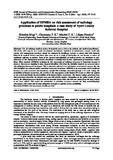| dc.description.abstract | Use of radiology medical devices in hospitals pose a risk to the patients and medical practitioners.
The device risks may be as a result of technical, operational, logistical or maintenance reasons. It for this
reason, risk management practices should be employed in healthcare systems to ensure that risks hazards
inherent in medical devices and those that come up as a result of interaction do not become a source of
additional suffering to patients. Some of the reported unavailability of medical devices are attributed to non-
adherence to risk management measures and failure to identify risks on time. Application of Healthcare Failure
Mode Effect Analysis (HFMEA) technique in risk assessment of radiology processes is important because it
ensures; that process mapping is done, hazards identified, risks from the identified hazards are assessed and a
risk mitigation framework developed. This is otherwise referred to as risk impact assessment.It ensures that the
risks identified are reduced and/or controlled to prevent recurrence. HFMEA as an assessment tool is preferred
because it is well structured and healthcare specific.The technique determinesthrough 1-10 scale rating; the
probability of hazard occurrence, the severity or the consequence of the hazard if it occurs to either the patient
or the system and finally the detectability of the hazard before occurrence. The hazard ratings generated from
risk assessment determine the hazard score and risk priority number. Depending on the rating results of each
device, the clinical processes involved and the potential device risks; the risks are ranked from the most critical
to the least critical. This assists the stakeholder to prioritize resources towards the high probability/high
consequence risk events and develop mitigation strategies to optimise device availability. | en_US |

